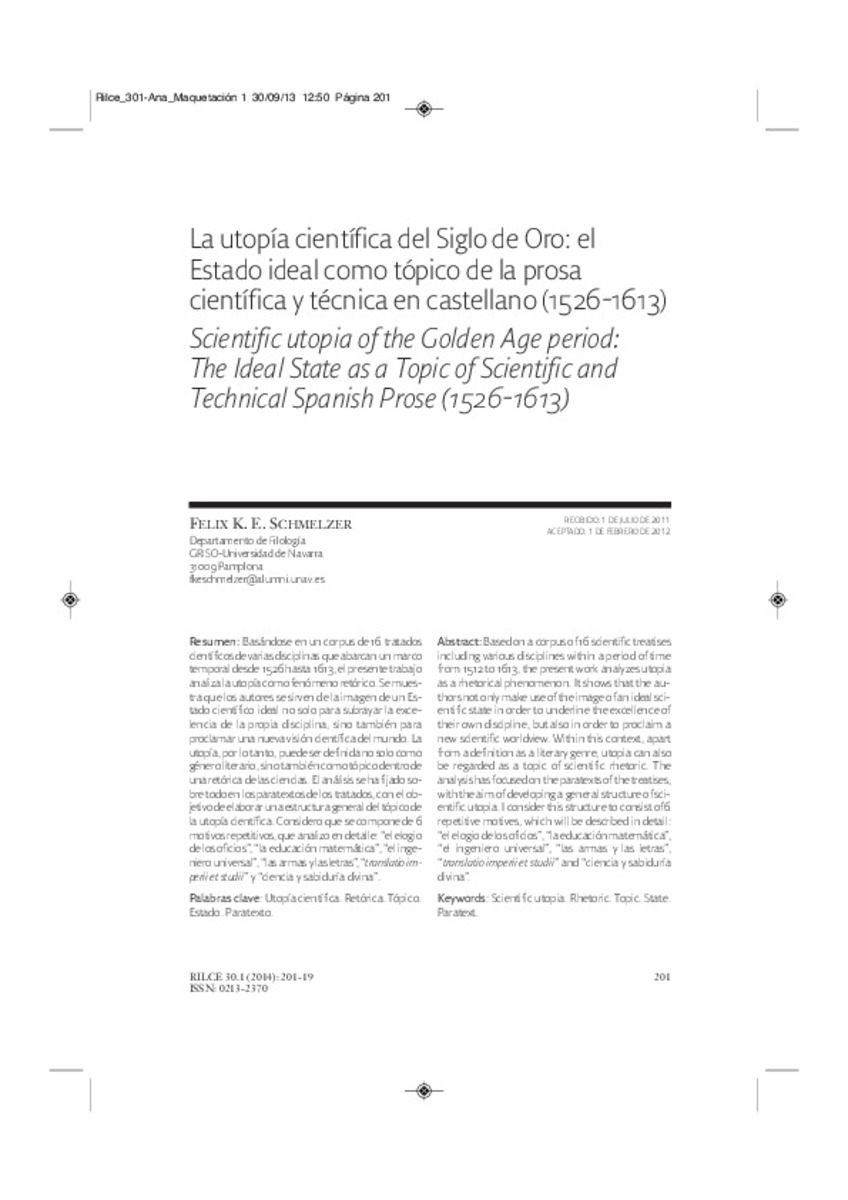Full metadata record
| DC Field | Value | Language |
|---|---|---|
| dc.creator | Schmelzer, F.K.E. (Felix K. E.) | - |
| dc.date.accessioned | 2014-10-31T13:24:58Z | - |
| dc.date.available | 2014-10-31T13:24:58Z | - |
| dc.date.issued | 2014 | - |
| dc.identifier.citation | Schmelzer, F.K.E. (2014). ""La utopía científica del Siglo de Oro: el Estado ideal como tópico de la prosa científica y técnica en castellano (1526-1613)"", Rilce, vol. 30, n.1, pp. 201-219. | es_ES |
| dc.identifier.issn | 0213-2370 | - |
| dc.identifier.uri | https://hdl.handle.net/10171/37001 | - |
| dc.description.abstract | Basándose en un corpus de 16 tratados científicos de varias disciplinas que abarcan un marco temporal desde 1526 hasta 1613, el presente trabajo analiza la utopía como fenómeno retórico. Se muestra que los autores se sirven de la imagen de un Estado científico ideal no solo para subrayar la excelencia de la propia disciplina, sino también para proclamar una nueva visión científica del mundo. La utopía, por lo tanto, puede ser definida no solo como género literario, sino también como tópico dentro de una retórica de las ciencias. El análisis se ha fijado sobre todo en los paratextos de los tratados, con el objetivo de elaborar una estructura general del tópico de la utopía científica. Considero que se compone de 6 motivos repetitivos, que analizo en detalle: “el elogio de los oficios”, “la educación matemática”, “el ingeniero universal”, “las armas y las letras”, “translatio imperii et studii” y “ciencia y sabiduría divina”. | es_ES |
| dc.description.abstract | Based on a corpus of 16 scientific treatises including various disciplines within a period of time from 1512 to 1613, the present work analyzes utopia as a rhetorical phenomenon. It shows that the authors not only make use of the image of an ideal scientific state in order to underline the excellence of their own discipline, but also in order to proclaim a new scientific worldview. Within this context, apart from a definition as a literary genre, utopia can also be regarded as a topic of scientific rhetoric. The analysis has focused on the paratexts of the treatises, with the aim of developing a general structure of scientific utopia. I consider this structure to consist of 6 repetitive motives, which will be described in detail: “el elogio de los oficios”, “la educación matemática”, “el ingeniero universal”, “las armas y las letras”, “translatio imperii et studii” and “ciencia y sabiduría divina”. | es_ES |
| dc.language.iso | spa | es_ES |
| dc.publisher | Servicio de Publicaciones de la Universidad de Navarra | es_ES |
| dc.rights | info:eu-repo/semantics/openAccess | es_ES |
| dc.subject | Utopía científica | es_ES |
| dc.subject | Retórica | es_ES |
| dc.subject | Tópico | es_ES |
| dc.subject | Estado | es_ES |
| dc.subject | Paratexto | es_ES |
| dc.subject | Scientific utopia | es_ES |
| dc.subject | Rhetoric | es_ES |
| dc.subject | Topic | es_ES |
| dc.subject | State | es_ES |
| dc.subject | Paratext | es_ES |
| dc.subject | Materias Investigacion::Filología y Literatura::Filología hispánica | es_ES |
| dc.title | La utopía científica del Siglo de Oro: el Estado ideal como tópico de la prosa científica y técnica en castellano (1526-1613) | es_ES |
| dc.title.alternative | Scientific utopia of the Golden Age period: The Ideal State as a Topic of Scientific and Technical Spanish Prose (1526-1613) | es_ES |
| dc.type | info:eu-repo/semantics/article | es_ES |
| dc.relation.publisherversion | https://revistas.unav.edu/index.php/rilce/index | es_ES |
| dc.identifier.doi | 10.15581/008.30.310 | es_ES |
Files in This Item:
Statistics and impact
Items in Dadun are protected by copyright, with all rights reserved, unless otherwise indicated.






